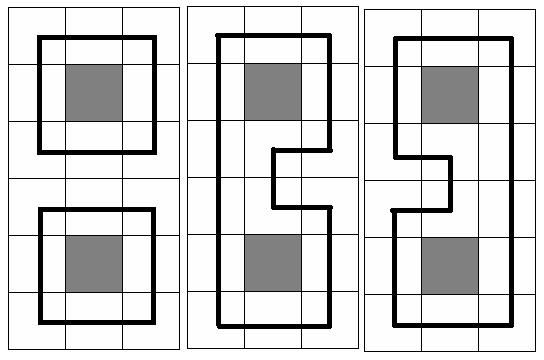标签:
Eat the Trees
Time Limit: 4000/2000 MS (Java/Others) Memory Limit: 32768/32768 K (Java/Others)
Total Submission(s): 5079 Accepted Submission(s):
2628
So Pudge’s teammates give him a new assignment—Eat the Trees!
The trees are in a rectangle N * M cells in size and each of the cells either has exactly one tree or has nothing at all. And what Pudge needs to do is to eat all trees that are in the cells.
There are several rules Pudge must follow:
I. Pudge must eat the trees by choosing a circuit and he then will eat all trees that are in the chosen circuit.
II. The cell that does not contain a tree is unreachable, e.g. each of the cells that is through the circuit which Pudge chooses must contain a tree and when the circuit is chosen, the trees which are in the cells on the circuit will disappear.
III. Pudge may choose one or more circuits to eat the trees.
Now Pudge has a question, how many ways are there to eat the trees?
At the picture below three samples are given for N = 6 and M = 3(gray square means no trees in the cell, and the bold black line means the chosen circuit(s))

Input The input consists of several test cases. The first line of the input is the number of the cases. There are no more than 10 cases.
For each case, the first line contains the integer numbers N and M, 1<=N, M<=11. Each of the next N lines contains M numbers (either 0 or 1) separated by a space. Number 0 means a cell which has no trees and number 1 means a cell that has exactly one tree.
Output For each case, you should print the desired number of ways in one line. It is guaranteed, that it does not exceed 263 – 1. Use the format in the sample.
Sample Input 2 6 3 1 1 1 1 0 1 1 1 1 1 1 1 1 0 1 1 1 1 2 4 1 1 1 1 1 1 1 1
Sample Output Case 1: There are 3 ways to eat the trees. Case 2: There are 2 ways to eat the trees.
Source 2008 “Sunline Cup” National Invitational Contest
Recommend wangye | We have carefully selected several similar problems for you: 1691 1695 1689 1692 1690
Solution 之前某次线上赛做过的题,还记得当时调到shi都过不了.... 重做一遍咸鱼翻身! 然而这道题几乎就是插头DP模板题叻,相对于普通的轮廓线每位代表的是一个格子,插头DP的轮廓线每一位代表的是每个边框。

如上图,每根红线代表的是插头DP中状态的每一位,特别的地方就在最后一位,那条横线,表示的是当前格子被更新时左边是否有向右的插头,而当前格子上面的竖线表示上面是否有向下的插头...
这样,插头DP的状态就比普通轮廓线多一位。
这两个位置就是转移的重点。
在当前格子上面有插头或者左边有插头,那么可以转移到当前向右或者向下;如果两个状态同时存在,那么将两个状态合并,不能新增插头;如果两个状态都不存在,并且没有障碍格,那么同时增加两个新插头。
第一列、最后一排、最后一列需要特判。
空间要开足!!!
Code
#include<bits/stdc++.h>
#define LL long long
using namespace std;
int n, m, G[12][12], ti;
LL dp[2][(1 << 12)];
int main() {
int T;
scanf("%d", &T);
while(T --) {
scanf("%d%d", &n, &m);
for(int i = 1; i <= n; i ++)
for(int j = 1; j <= m; j ++)
scanf("%d", &G[i][j]);
memset(dp, 0, sizeof(dp));
int now = 0;
dp[now][0] = 1;
for(int i = 1; i <= n; i ++) {
for(int j = 1; j <= m; j ++) {
now ^= 1;
memset(dp[now], 0, sizeof(dp[now]));
for(int s = 0; s < (1 << m + 1); s ++) {
int pre = s & (1 << m);
int las = s & 1;
if(!G[i][j]) {
int ss = (s << 1);
if(!pre && !las) dp[now][ss] += dp[now ^ 1][s];
} else {
if(j != 1) {
if(pre && las) {
int ss = (s ^ pre ^ las) << 1;
dp[now][ss] += dp[now ^ 1][s];
}
if(pre && !las) {
int ss = (s ^ pre) << 1 | 1;
if(j != m) dp[now][ss] += dp[now ^ 1][s];
ss = (s ^ pre) << 1 | 2;
if(i != n) dp[now][ss] += dp[now ^ 1][s];
}
if(!pre && las) {
int ss = (s ^ las) << 1 | 1;
if(j != m) dp[now][ss] += dp[now ^ 1][s];
ss = (s ^ las) << 1 | 2;
if(i != n) dp[now][ss] += dp[now ^ 1][s];
}
if(!pre && !las) {
int ss = s << 1 | 3;
dp[now][ss] += dp[now ^ 1][s];
}
} else if(j == 1 && !las) {
if(pre) {
int ss = (s ^ pre) << 1 | 2;
if(i != n) dp[now][ss] += dp[now ^ 1][s];
ss = (s ^ pre) << 1 | 1;
if(j != m) dp[now][ss] += dp[now ^ 1][s];
} else {
if(i != n && j != m) {
int ss = s << 1 | 3;
dp[now][ss] += dp[now ^ 1][s];
}
}
}
}
}
}
}
printf("Case %d: There are %lld ways to eat the trees.\n", ++ti, dp[now][0]);
}
}
标签: 来源: https://www.cnblogs.com/wans-caesar-02111007/p/9796038.html
本站声明: 1. iCode9 技术分享网(下文简称本站)提供的所有内容,仅供技术学习、探讨和分享; 2. 关于本站的所有留言、评论、转载及引用,纯属内容发起人的个人观点,与本站观点和立场无关; 3. 关于本站的所有言论和文字,纯属内容发起人的个人观点,与本站观点和立场无关; 4. 本站文章均是网友提供,不完全保证技术分享内容的完整性、准确性、时效性、风险性和版权归属;如您发现该文章侵犯了您的权益,可联系我们第一时间进行删除; 5. 本站为非盈利性的个人网站,所有内容不会用来进行牟利,也不会利用任何形式的广告来间接获益,纯粹是为了广大技术爱好者提供技术内容和技术思想的分享性交流网站。
